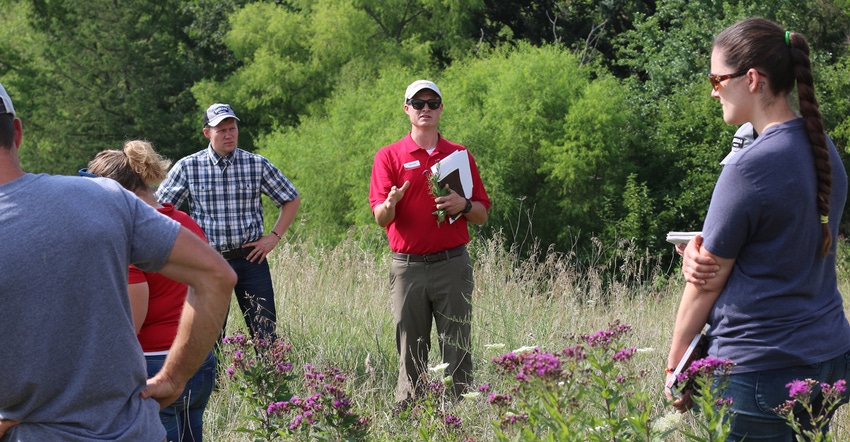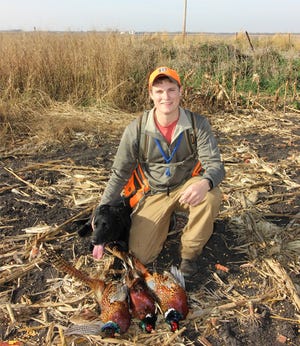January 23, 2020

As we embark on a new decade, Iowa Learning Farms invited Iowa State University assistant professor and Extension wildlife specialist Adam Janke to put together a list of conservation-minded things everyone should consider trying in the 2020s. In the Conservation Chat podcast in December, he explains the list and how looking to the next decade can help improve diversity in the ecosystem we all share.
Throughout the conversation with ILF Director Jacqueline Comito, Janke touches on several key themes including land stewardship, diversity in all forms, and becoming invested in native species of plants and animals indigenous to the land. He conducts research and provides education on finding opportunities for strengthening wildlife habitat conservation on working landscapes.
“As a wildlife biologist, I focus on all forms of creatures from invertebrates to birds and mammals. But the interconnection of wildlife with plant diversity, habitat availability and the ag and natural ecosystems are complex yet extremely important to the health of both our environment and the agricultural enterprise in Iowa. As good stewards of the land, we shouldn’t just take conservation actions, we should share our stories and ideas with others — most particularly with the next generation,” he says.
Connecting to conservation
Paying closer attention to the world around us and sharing our stories of personal connection to the land and land stewardship are common themes throughout the chat. Janke frequently emphasizes the importance of engaging with young people, hopefully instilling them with strong conservation values.
Ongoing communication and education about Iowa’s environment and conservation activities are crucial to maintaining and sustaining Iowa’s economic and natural strengths. “Programs such as Water Rocks!, ILF, ISU Extension and many others provide broad opportunities for education and outreach,” he says. “Encouraging individuals to get involved and share their conservation stories are also powerful tools to help build kinship with nature and the land.”
Highlighting the theme of seeing and embracing what surrounds you, suggestions Nos. 19 through 16 include letting the snow be a learning canvas by observing wildlife tracks, listening to bird calls and identifying several common Iowa birds, being on the lookout for rare species, and knowing your watershed address.
Paying attention to nature
“It can be so interesting to simply pay attention to what’s around you,” Janke says. “I love birds, and there are three birdcalls I think everyone should listen for and be able to identify. The dickcissel, upland sandpiper and eastern wood-pewee. All spend the summer in Iowa and add so much to the audible landscape before journeying to Central and South America for the winter. And among the rare animals that call Iowa home are the eastern spotted skunk and the white-tailed jackrabbit, whose populations have diminished over time primarily due to habitat changes.”
 WILDLIFE: While much attention today is focused on water quality-related conservation practices, the practices suggested by Adam Janke also offer great benefits to wildlife.
WILDLIFE: While much attention today is focused on water quality-related conservation practices, the practices suggested by Adam Janke also offer great benefits to wildlife.

With No. 15, Janke encourages everyone to buy a Duck Stamp every year. Duck Stamps are issued each year as hunting permits, but these $1 stamps also grant access to any National Wildlife Refuge and the revenue generated by sales supports waterfowl conservation efforts.
Nos. 13, 12, 6 and 5 relate to the importance of native plants, the beauty they provide, and important roles they play in the environment. “Choosing a broad variety of native plants which bloom at different times throughout the summer months provides habitat and a beautiful landscape, while offering birds and insects a variety of fruits, seeds and nectars to support the food chain,” he notes.
Not without controversy, Janke’s No. 9 is “Sell the lawnmower (or at least downsize).” He isn’t shy about his feelings toward large manicured lawns. He says they are simply a waste of good habitat. He adds, “I’d like to change the common aesthetic perception of what makes a beautiful yard. Move away from an acre or more of short green grass to a diverse area of native flowers and plants, which provides homes to many native animal species. I understand this is a big request, so if I can suggest that people mow less and mow less often, it will make an impact.”
What you need to read
On the list, No. 7 is the first of two reading recommendations. “Braiding Sweetgrass” by Robin Wall Kimmerer entwines indigenous wisdom, scientific knowledge and the teaching of plants. Written from a Native American perspective and speaking to a nation of immigrants, the book provides an excellent message about becoming invested in our environment and indigenous to the place we call home.
Another must-read book is No. 4 on the list. Janke highly recommends reading (and rereading) “A Sand County Almanac” by Aldo Leopold.
With item No. 3, Janke wants to extend what it means to run a clean farm. He’d like to move beyond the idea of a well-maintained and operated farm to include looking downstream and incorporating actions that support and promote wildlife diversity on the production margins. He adds, “A clean farm is one that selfishly keeps its soil to itself. Why share your most valuable asset with downstream neighbors? When clean water leaves the farm, you are doing right things on your land while making sure downstream neighbors are protected.”
Wrapping up the list for the 2020s, Janke sets the highest priority on embracing diversity in all its forms: economically, biologically and socially. Doing so will allow for increased resiliency and will have wildlife benefits, as well as improving soil health and water quality across our agricultural landscape. “We need diversity of thought and we need diversity of ideas to solve some of these really big challenges we have, in terms of sustaining our land base, sustaining our rural communities and sustaining this enterprise that we all really value,” he concludes.
The list of conservation considerations follows:
20. Download iNaturalist or a similar app.
19. Look for tracks in the snow.
18. Learn to recognize three bird calls: the Dickcissel, Upland Sandpiper and Eastern Wood-Pewee.
17. Learn to recognize rare wildlife.
16. Learn your watershed address.
15. Buy a duck stamp.
14. Keep cats inside.
13. Plant native plants.
12. Be able to make a bouquet of flowers from your land from May 15 to Oct. 1.
11. Take the Master Conservationist Program.
10. Volunteer and get involved.
9. Sell the mower (or at least downsize).
8. Take kids to your favorite natural area often and talk to them about why it’s so important.
7. Read “Braiding Sweetgrass” by Robin Wall Kimmerer.
6. Find opportunity areas of wildlife on your farm or land (check on Janke’s Iowa Learning Farms webinar to learn more).
5. Redefine your relationship to “weeds”.
4. Read (or reread) “A Sand County Almanac” by Aldo Leopold.
3. Run a “clean farm,” but broaden the definition of that to include protecting soil, making sure clean water is leaving your property, and supporting biodiversity and wildlife on the margins of productive land.
2. Tell your story about why land stewardship matters to you.
1. Embrace diversity in all of its forms: economically, biologically and socially.
Ripley is an Iowa Learning Farms conservation outreach specialist.
You May Also Like




